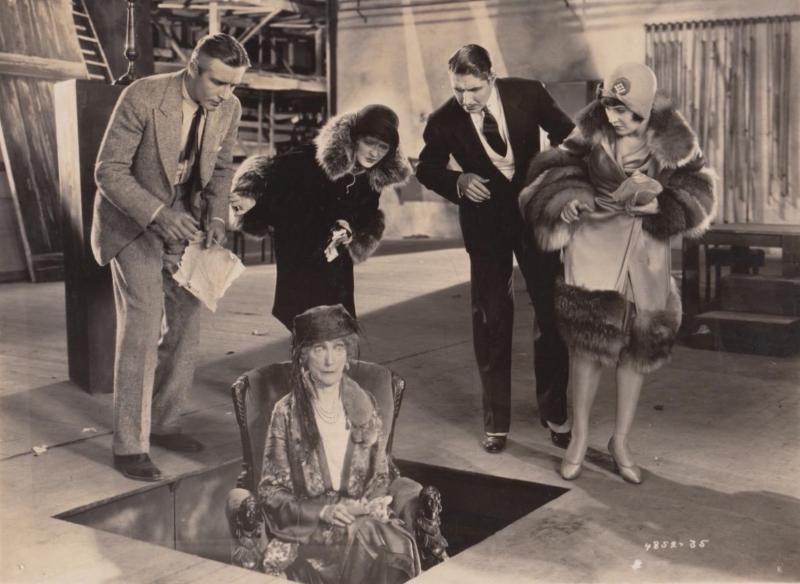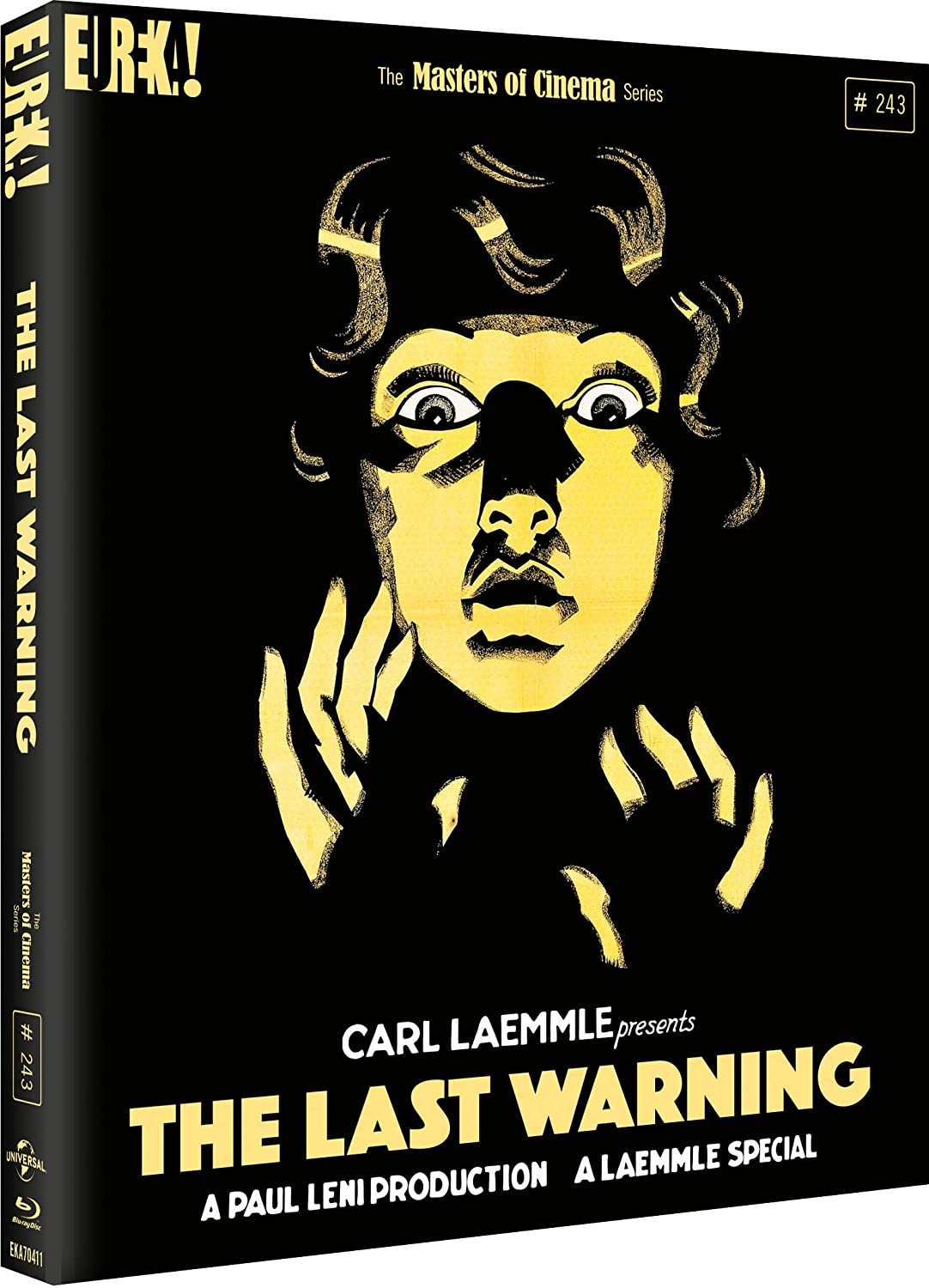Blu-ray: The Last Warning | reviews, news & interviews
Blu-ray: The Last Warning
Blu-ray: The Last Warning
Paul Leni's backstage murder farce is a magicianly tour de force

Stuttgart-born auteur and film theoretician Paul Leni, whose illusionistic production designs and direction of Waxworks (1924) helped define German Expressionist cinema, was 44 and approaching master status when he died of sepsis on 2 September 1929.
The Last Warning derived from Thomas F. Fallon’s Broadway melodrama, itself adapted from Charles Wadsworth Camp’s 1916 mystery novel House of Fear. The inciting incident of the play, which ran from October 1922 to May 1923, is the murder of a celebrated actor manager, who was involved in a love triangle. Was it a coincidence that the 49-year-old Anglo-Irish Hollywood director-actor William Desmond Taylor had been murdered in his Los Angeles bungalow nearly nine months before the play opened? The sensationalized unsolved case, which cast suspicion on Taylor’s actor-filmmaker lover Mabel Normand and his actor admirer Mary Miles Minter (as well as her mother), was still being updated in the fall of ‘22.
The 1928 film is unsung partially because it defies easy categorisation. Whereas The Cat and the Canary is a comedy horror film both humorous and scary, its companion piece is an intricately staged but narratively absurd haunted house-cum-murder mystery farce that laughs at its supernaturalism and delivers not a single scare. Laura La Plante is the nominal star, but she's upstaged at every turn by the more animated and endlessly treacherous labyrinthine Broadway theatre set, that built for Lon Chaney's 1925 The Phantom of the Opera.
 Yet The Last Warning is as delightful as a Rube Goldberg machine, a film affording a ceaseless barrage of abruptly sprung traps and nastily contrived accidents that self-consciously celebrates hydraulic stage effects and glories in cinematographer Hal Mohr's virtuosic sleights of camera and startling use of low-angle shots, dolly shots, and close-ups. Leni evidently regarded the uninvolving mystery as a conduit for exploring the psychological effects on the audience of his manipulation of a visual space (unusually deep for the time) that constantly threatens its inhabitants with its instability: scenery topples and floors give way; hidden passages open; ghosts, spiders, and scrawled warnings appear. That the flawless mechanical logic motors events that have no rhyme or reason in terms of human agency is prophetic: to mix metaphors, the machines have taken over the asylum.
Yet The Last Warning is as delightful as a Rube Goldberg machine, a film affording a ceaseless barrage of abruptly sprung traps and nastily contrived accidents that self-consciously celebrates hydraulic stage effects and glories in cinematographer Hal Mohr's virtuosic sleights of camera and startling use of low-angle shots, dolly shots, and close-ups. Leni evidently regarded the uninvolving mystery as a conduit for exploring the psychological effects on the audience of his manipulation of a visual space (unusually deep for the time) that constantly threatens its inhabitants with its instability: scenery topples and floors give way; hidden passages open; ghosts, spiders, and scrawled warnings appear. That the flawless mechanical logic motors events that have no rhyme or reason in terms of human agency is prophetic: to mix metaphors, the machines have taken over the asylum.
These disturbances occur because, five years after the theatre company’s actor-producer luminary was scandalously slain during a performance before a full house, a bullish new producer (Montagu Love) no one knows shows up to announce he’s re-staging the cursed play in which his friend died, and in the same condemned theatre. Hd aims to expose the killer. The nervy leading lady (La Plante, who starred in The Cat and Canary) and her protective lover the director (John Boles), both suspects, are obliged to cooperate; so is everyone else.
Leni’s formidable ensemble includes Margaret Livingston (the seductive “Woman From the City” in F.W. Murnau’s Sunrise), Mack Swain (hulking adversary of Charlie Chaplin’s Tramp), Roy D’Arcy (exotic villain specialist), comedy reliables Bert Loach and Slim Summerville, and the Belgian bit-part player Carrie Daumery (a Man Who Laughs alumna who worked often with Greta Garbo). Though only 55, Daumery is a hoot as the stage company ancient who pauses from being shocked to simper when the new producer notices her. There’s a vaudevillian, even Dickensian aspect to some of the physiognomies, though the emotive acting style that characterizes many silent films was fading out in 1928 – the relatively restrained facial expressions and body language of actors like La Plante, Boles, Livingston, and Love is no different to ours.
Restored in 4K and making its UK home video debut, The Last Warning arrives on a Masters of Cinema Blu-ray featuring the silent version (the fleeting talkie scenes, which allegedly included screams and eerie noises but little talk, are no longer extant). The insouciant new score was composed by Arthur Barrow. Horror-fantasy authors Stephen Jones and Kim Newman provide the audio commentary. Film scholar John T. Soister contextualizes the film as a product of Universal's unmatched horror stable, but his comments about Laemmle and his son and heir, Carl Jr., who oversaw the successful Dracula–Frankenstein era, are baffling.
The future of Arts Journalism
You can stop theartsdesk.com closing!
We urgently need financing to survive. Our fundraising drive has thus far raised £49,000 but we need to reach £100,000 or we will be forced to close. Please contribute here: https://gofund.me/c3f6033d
And if you can forward this information to anyone who might assist, we’d be grateful.

Subscribe to theartsdesk.com
Thank you for continuing to read our work on theartsdesk.com. For unlimited access to every article in its entirety, including our archive of more than 15,000 pieces, we're asking for £5 per month or £40 per year. We feel it's a very good deal, and hope you do too.
To take a subscription now simply click here.
And if you're looking for that extra gift for a friend or family member, why not treat them to a theartsdesk.com gift subscription?
more Film
 Spinal Tap II: The End Continues review - comedy rock band fails to revive past glories
Belated satirical sequel runs out of gas
Spinal Tap II: The End Continues review - comedy rock band fails to revive past glories
Belated satirical sequel runs out of gas
 Downton Abbey: The Grand Finale review - an attemptedly elegiac final chapter haunted by its past
Noel Coward is a welcome visitor to the insular world of the hit series
Downton Abbey: The Grand Finale review - an attemptedly elegiac final chapter haunted by its past
Noel Coward is a welcome visitor to the insular world of the hit series
 Islands review - sunshine noir serves an ace
Sam Riley is the holiday resort tennis pro in over his head
Islands review - sunshine noir serves an ace
Sam Riley is the holiday resort tennis pro in over his head
 theartsdesk Q&A: actor Sam Riley on playing a washed-up loner in the thriller 'Islands'
The actor discusses his love of self-destructive characters and the problem with fame
theartsdesk Q&A: actor Sam Riley on playing a washed-up loner in the thriller 'Islands'
The actor discusses his love of self-destructive characters and the problem with fame
 Honey Don’t! review - film noir in the bright sun
A Coen brother with a blood-simple gumshoe caper
Honey Don’t! review - film noir in the bright sun
A Coen brother with a blood-simple gumshoe caper
 The Courageous review - Ophélia Kolb excels as a single mother on the edge
Jasmin Gordon's directorial debut features strong performances but leaves too much unexplained
The Courageous review - Ophélia Kolb excels as a single mother on the edge
Jasmin Gordon's directorial debut features strong performances but leaves too much unexplained
 Blu-ray: The Graduate
Post #MeToo, can Mike Nichols' second feature still lay claim to Classic Film status?
Blu-ray: The Graduate
Post #MeToo, can Mike Nichols' second feature still lay claim to Classic Film status?
 Little Trouble Girls review - masterful debut breathes new life into a girl's sexual awakening
Urska Dukic's study of a confused Catholic teenager is exquisitely realised
Little Trouble Girls review - masterful debut breathes new life into a girl's sexual awakening
Urska Dukic's study of a confused Catholic teenager is exquisitely realised
 Young Mothers review - the Dardennes explore teenage motherhood in compelling drama
Life after birth: five young mothers in Liège struggle to provide for their babies
Young Mothers review - the Dardennes explore teenage motherhood in compelling drama
Life after birth: five young mothers in Liège struggle to provide for their babies
 Blu-ray: Finis Terrae
Bleak but compelling semi-documentary, filmed on location in Brittany
Blu-ray: Finis Terrae
Bleak but compelling semi-documentary, filmed on location in Brittany
 Oslo Stories Trilogy: Sex review - sexual identity slips, hurts and heals
A quietly visionary series concludes with two chimney sweeps' awkward sexual liberation
Oslo Stories Trilogy: Sex review - sexual identity slips, hurts and heals
A quietly visionary series concludes with two chimney sweeps' awkward sexual liberation
 Sorry, Baby review - the healing power of friendship in the aftermath of sexual assault
Eva Victor writes, directs and stars in their endearing debut feature
Sorry, Baby review - the healing power of friendship in the aftermath of sexual assault
Eva Victor writes, directs and stars in their endearing debut feature

Add comment